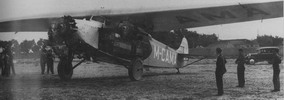1931-1935
![]()
1931-1935

![]()








![]()
The Fokker F-VIIb was the successor to the successful single-engined Fokker
F-VII.
When Henry Ford organized his first annual Ford Reliability Tour for airplanes
in the autumn of 1925, Fokker quickly ordered his factory in Amsterdam to add
an additional engine under each wing of the F-VII and to ship the plane to America
to compete for the Ford Trophy. Thus was born the Fokker F-VII Trimotor, probably
the most popular airliner in the world during the 1920s. This dependable aircraft
was to make aviation history many times.
The Trimotor became the first three-engine airliner in the United States when
it was entered in the 1925 Ford Reliability Tour. Sixteen other planes were
also in this competition, which included 1,900 miles of flying and landings
in 13 Midwestern cities. Piloting his high-wing monoplane himself much of the
time, Fokker easily placed first. Immediately thereafter he ordered his three-engine
transport into production.
Fokker's F-VII probably had more "firsts" to its credit than any other
aircraft--before or since. For example, in 1926 an F-VII named the Josephine
Ford carried Richard Byrd and Floyd Bennett over the North Pole. In 1928 Australia's
Sir Charles Kingsford-Smith spanned the Pacific Ocean from Oakland, California
to Brisbane, Australia in his Southern Cross .
Swissair herited its share of Fokker VIIb's from balair and ad
astra , its predecessor companies, who bought them at a unit price of CHF 185'200 each, and flew them until 1935.
![]()
Manufacturer |
Fokker, Amsterdam (NL) |
| Span |
21.70
m
|
Length |
14.60 m |
Height |
4.50 m |
Power
(HP) |
3
x 200 |
Cruising
Speed |
180-190 km/h |
Passengers |
8-10 |
Range |
> 800 km |
Area
of Operation |
Europe |
![]()
![]()
 |
|||||||
![]()
![]()
![]() Please
make sure you read the disclaimer regarding copyrights etc.
Please
make sure you read the disclaimer regarding copyrights etc.
last update January 2009